Miso glazed eggplant transformed my understanding of how a simple vegetable could become the star of any meal. Growing up, I’ll admit I was one of those people who wrinkled my nose at eggplant – until I discovered this incredible Japanese technique during my first cooking adventure in a friend’s kitchen. The moment that sweet, umami-rich glaze hit the perfectly tender eggplant under the broiler, creating those beautiful caramelized bubbles, I knew I had found something special.
Hi, I’m Olivia, and I’m thrilled to share this recipe that has become one of my absolute favorites at CookFoody.com. This miso glazed eggplant delivers restaurant-quality results with ingredients you can easily find, and the technique is so simple that even kitchen beginners will feel like accomplished chefs. Today, I’ll walk you through everything from selecting the perfect eggplant to mastering the ideal broiling distance, plus share some incredible variations that will keep this dish exciting meal after meal.
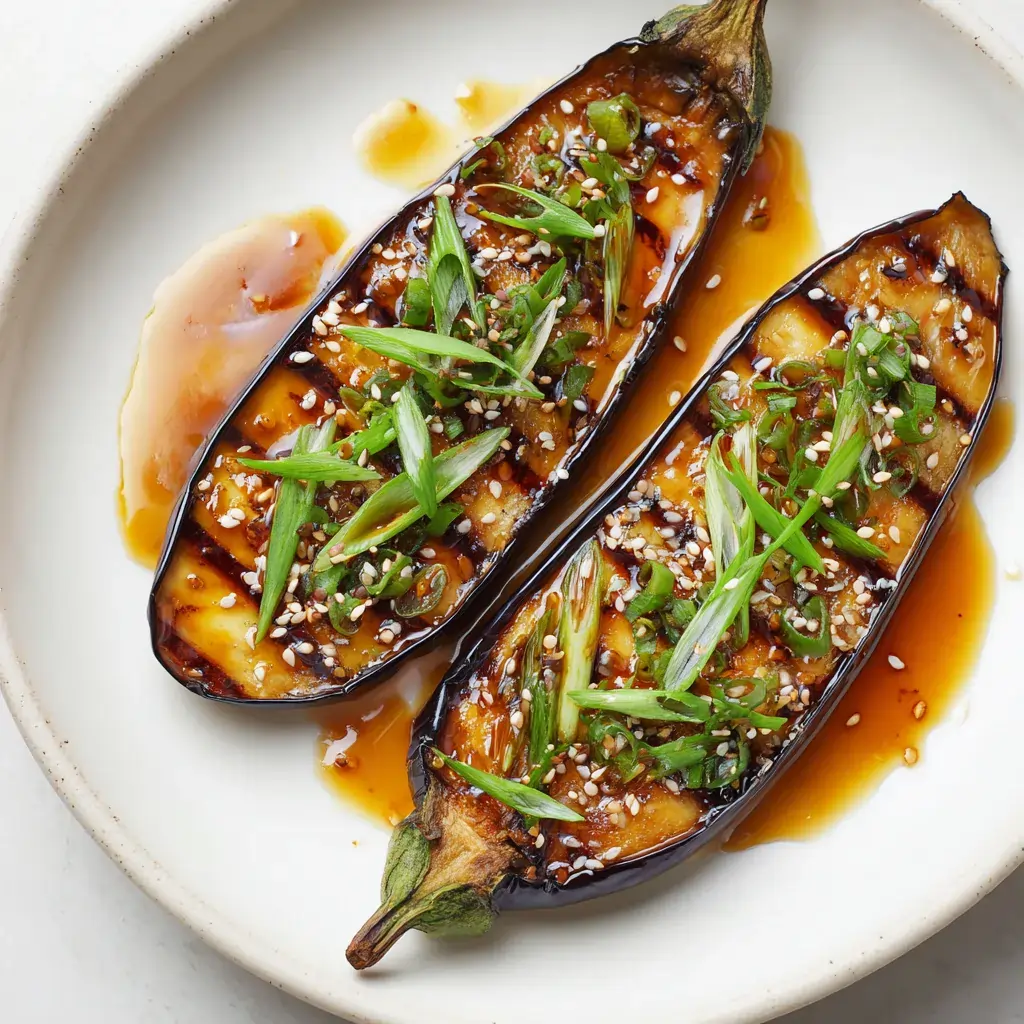
Why This Miso Glazed Eggplant Recipe Works
This miso glazed eggplant recipe succeeds where so many eggplant dishes fail because it addresses the three biggest challenges home cooks face with this versatile vegetable: removing bitterness, achieving the perfect texture, and creating bold, memorable flavor.
• Uses accessible ingredients that deliver authentic Japanese flavors – White miso, mirin, and sake create a complex glaze that tastes like it came from a high-end restaurant • Simple scoring and soaking technique eliminates eggplant’s natural astringency – No more bitter, unpleasant aftertastes that turn people away from eggplant • Dual cooking method ensures perfect texture every time – Baking first, then broiling creates tender flesh with a beautifully caramelized surface • Naturally vegetarian and adaptable to various dietary needs – Perfect for plant-based meals while satisfying enough to please meat-eaters • Ready in just 30 minutes from start to finish – Ideal for busy weeknights when you want something special without spending hours in the kitchen
Choosing the Right Eggplant for Miso Glazed Eggplant
Selecting the perfect eggplant makes all the difference in achieving that melt-in-your-mouth texture that makes this miso glazed eggplant so irresistible.
Best Varieties for This Miso Glazed Eggplant Recipe
Japanese eggplants are the gold standard for this recipe because their slender shape and tender skin cook evenly and absorb the miso glaze beautifully. These purple beauties have fewer seeds and less bitter compounds than their larger cousins, making them naturally sweeter and more delicate. Chinese eggplants work wonderfully as a substitute, offering similar characteristics with their elongated shape and thin skin. Italian eggplants, while slightly different in texture, also perform well when you can’t find Asian varieties.
Buying Tips for Perfect Miso Glazed Eggplant
Look for eggplants with glossy, unblemished skin that feels firm to the touch – they should have a slight give when pressed gently but never feel spongy. The stem should appear fresh and green, not brown or dried out, which indicates the eggplant was recently harvested. Size matters too: choose eggplants that feel heavy for their size, as this indicates good moisture content and fewer air pockets inside.
Substitutions for Your Miso Glazed Eggplant
While Japanese eggplants are ideal, you can absolutely use regular globe eggplants by cutting them into thick rounds or lengthwise slabs. The cooking time may need adjustment, and you might want to salt them for 20 minutes before cooking to draw out extra moisture. Baby eggplants work beautifully for individual servings, while white eggplants offer a milder flavor that some prefer.
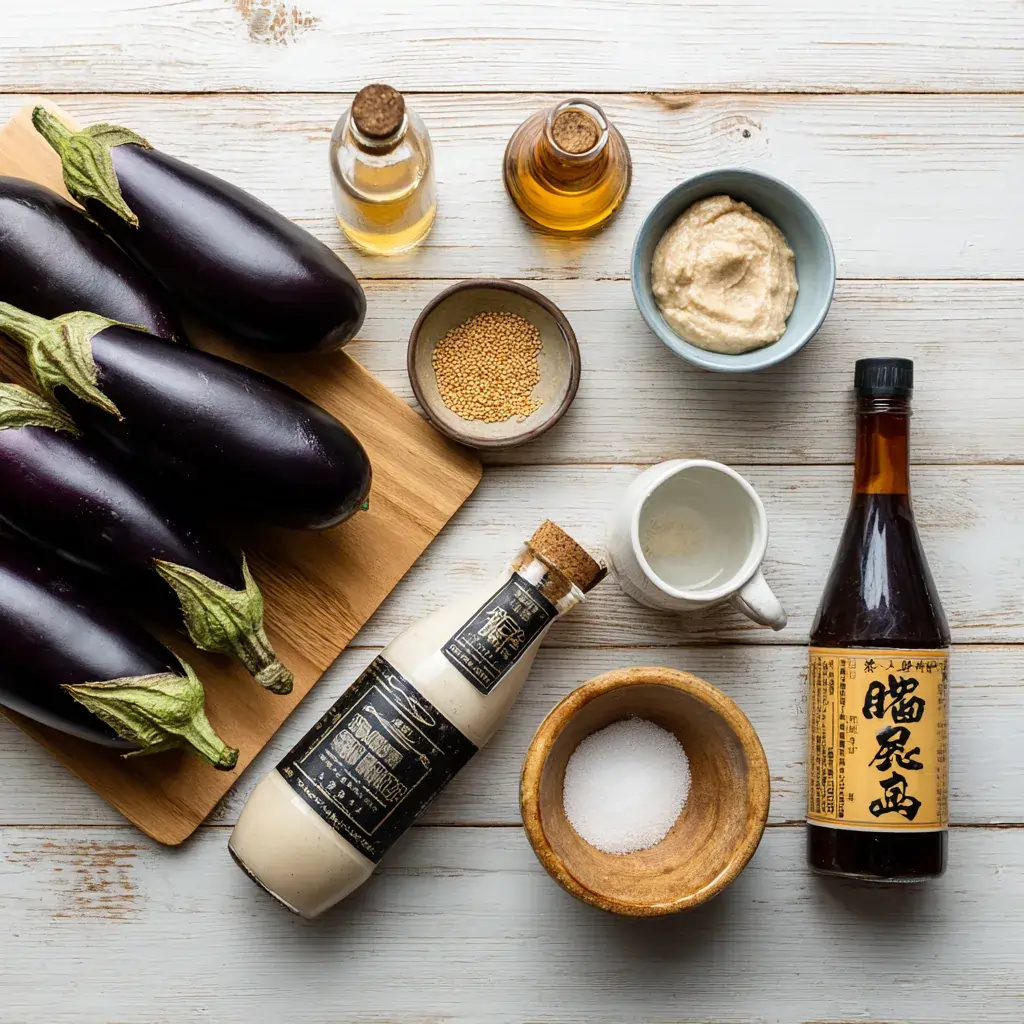
Ingredients & Prep for Miso Glazed Eggplant
The magic of this miso glazed eggplant lies in the careful balance of ingredients and proper preparation techniques that ensure every bite is perfectly seasoned and tender.
Eggplant Prep Essentials for Miso Glazed Eggplant
Start by cutting your eggplants in half lengthwise, then score the flesh in a crisscross pattern about ⅛ inch deep and apart. This scoring technique is crucial because it helps the eggplant cook faster, absorb more of that incredible miso glaze, and creates an attractive presentation that looks restaurant-worthy. After scoring, soak the cut eggplants in cool water for 10 minutes to remove any lingering astringency, then pat them completely dry with paper towels.
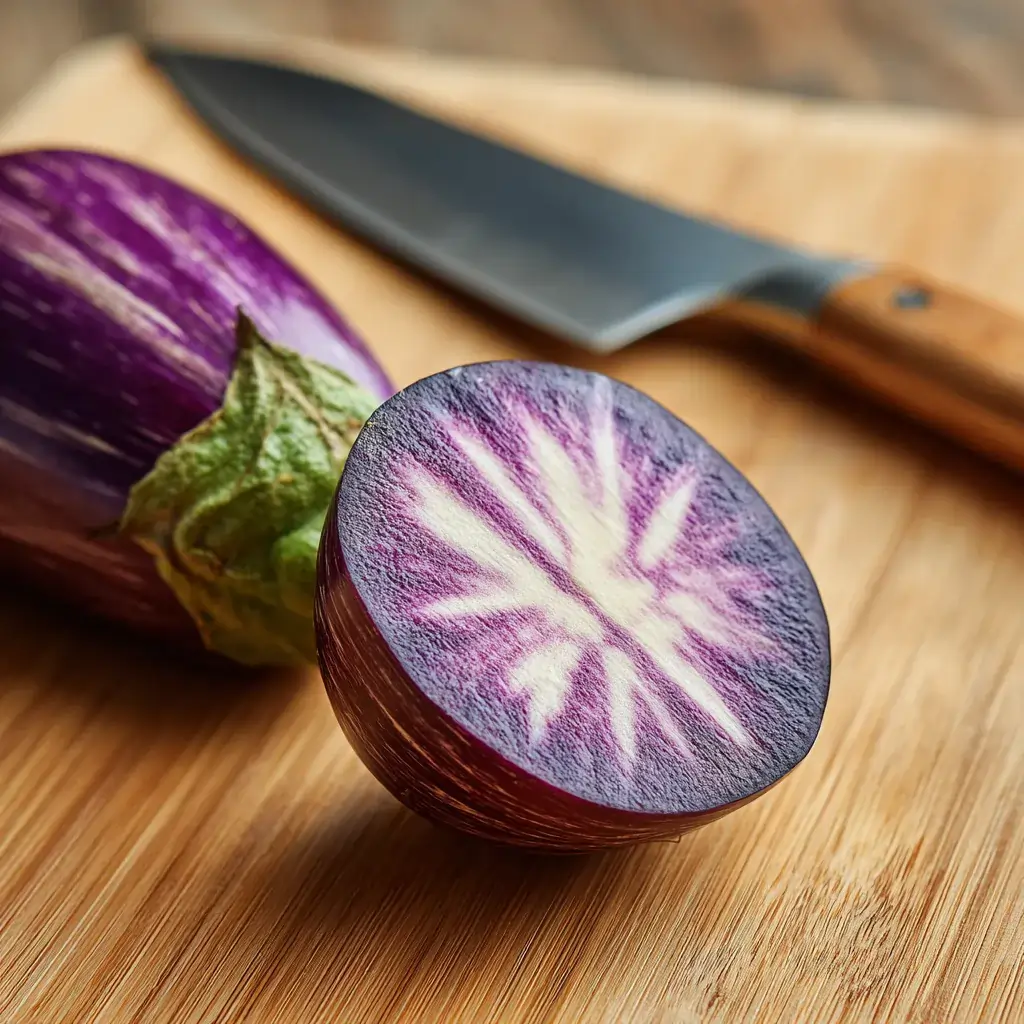
The Perfect Miso Glaze for Miso Glazed Eggplant
The glaze begins with white miso, which I prefer for its mild, sweet flavor that won’t overpower the delicate eggplant. Mix the miso with sugar until smooth, then gradually add mirin for sweetness and sake for depth. The consistency should be thick enough to coat the eggplant but thin enough to spread easily – adjust with additional sake if needed.
Essential Pantry Staples for Miso Glazed Eggplant
Toasted sesame oil provides the foundation for cooking, adding nutty richness that complements the miso beautifully. Keep quality miso paste in your refrigerator – it lasts for months and opens up a world of Japanese cooking possibilities. Mirin and sake are worth investing in for authentic flavor, though you can substitute with the ratios I’ve provided if needed.
Step-by-Step Cooking Instructions for Miso Glazed Eggplant
Following these precise steps ensures your miso glazed eggplant turns out perfectly tender with a gorgeous caramelized glaze every single time.

Pre-Cooking Prep for Miso Glazed Eggplant
Begin by preheating your oven to 425°F and lining a baking sheet with parchment paper. Prepare your miso glaze by combining all ingredients until smooth – this can be done up to a day ahead and stored in the refrigerator. Score and soak your eggplants as described, then pat them completely dry. Brush the cut surfaces generously with toasted sesame oil, ensuring every scored crevice is coated.
Cooking Method for Perfect Miso Glazed Eggplant
Place the eggplants cut-side down on your prepared baking sheet and bake for 15-20 minutes, until the skin begins to shrivel and the flesh feels tender when gently pressed. The timing depends on the size of your eggplants, so check them after 15 minutes. Remove from the oven and preheat your broiler while the eggplants cool slightly.
Glazing and Finishing Your Miso Glazed Eggplant
Carefully flip the eggplants cut-side up and brush the surface with your miso glaze, making sure to work it into the scored lines. Don’t overload them – a thin, even coating is perfect. Place under the broiler, positioned about 7 inches from the heating element, and broil for 3-5 minutes until the glaze bubbles and caramelizes beautifully.
Final Touches for Restaurant-Quality Miso Glazed Eggplant
Remove from the broiler and let rest for 2-3 minutes to allow the glaze to set slightly. The eggplant should be completely tender throughout, and the glaze should have a gorgeous golden-brown color with slightly charred edges that add incredible depth of flavor.
Pro Tips for Perfect Miso Glazed Eggplant
These insider techniques will elevate your miso glazed eggplant from good to absolutely spectacular, ensuring consistent results every time you make this dish.
Avoiding Common Mistakes with Miso Glazed Eggplant
Never skip the scoring step – it’s what allows the eggplant to cook evenly and absorb maximum flavor from the glaze. Don’t rush the initial baking phase; properly cooked eggplant should feel completely tender before you add the glaze. Watch the broiling carefully, as the sugars in the miso glaze can go from perfectly caramelized to burnt in seconds.
Essential Tools for Miso Glazed Eggplant Success
A sharp paring knife makes scoring effortless and precise, while a pastry brush ensures even glaze application. Use parchment paper to prevent sticking and make cleanup easier. An instant-read thermometer isn’t necessary here, but a timer is crucial for monitoring the broiling stage.
Storage & Reheating Your Miso Glazed Eggplant
Leftover miso glazed eggplant keeps in the refrigerator for up to 3 days and actually tastes wonderful cold as part of a Japanese-inspired salad. To reheat, use a toaster oven or regular oven at 350°F for 5-7 minutes rather than the microwave, which can make the texture soggy.
Flavor Variations for Miso Glazed Eggplant
Transform your basic miso glazed eggplant into exciting new dishes with these creative variations that showcase different flavor profiles and dietary preferences.
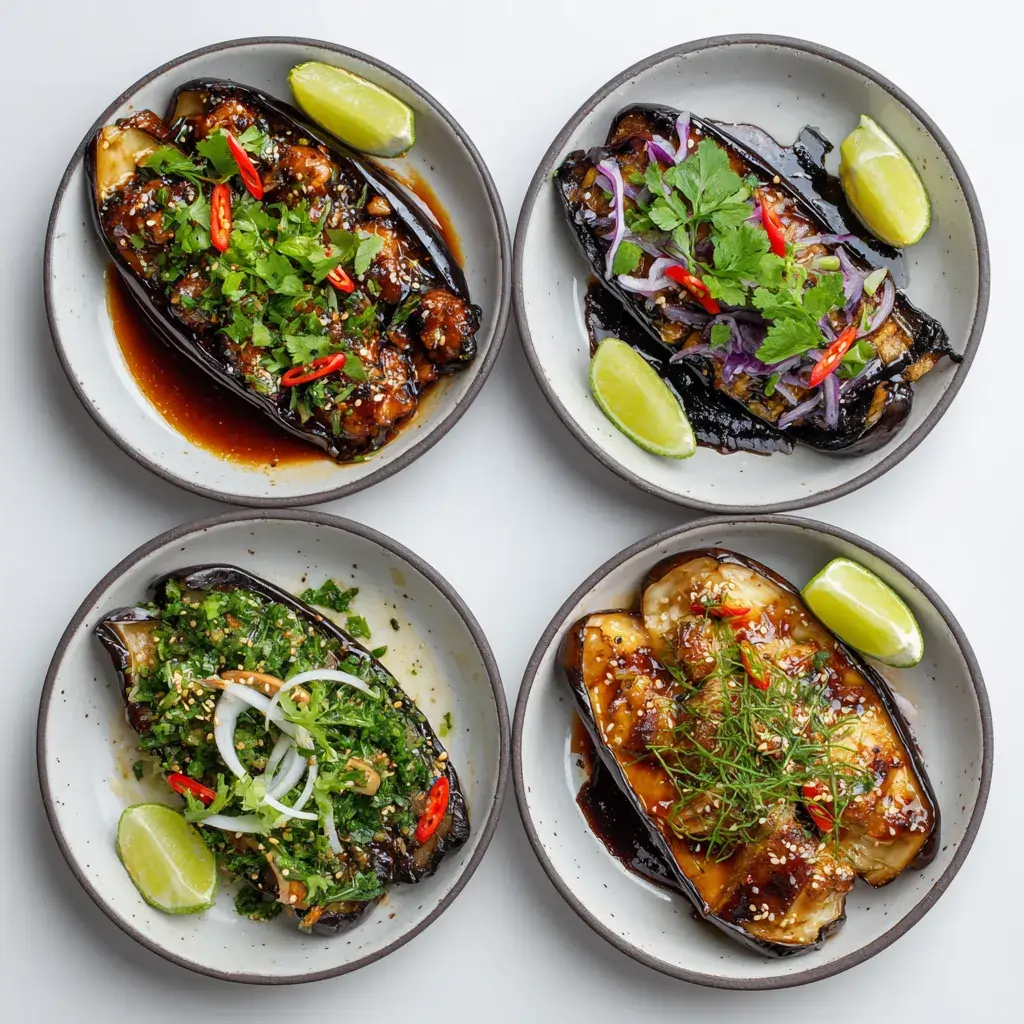
Spicy Miso Glazed Eggplant Twist
Add a teaspoon of gochujang or sriracha to your miso glaze for a Korean-inspired version that brings gentle heat and fermented complexity. For a Japanese approach, mix in a small amount of yuzu kosho – that bright, spicy citrus paste that adds incredible depth. Sprinkle with togarashi (Japanese seven spice) after broiling for extra heat and beautiful color contrast.
Low-Carb and Keto-Friendly Miso Glazed Eggplant
This recipe is naturally low in carbs, but you can make it even more keto-friendly by reducing the mirin and substituting with rice vinegar plus a keto-friendly sweetener like erythritol. The umami-rich miso provides all the flavor satisfaction you need without relying on heavy sauces or breadcrumbs.
Global Fusion Miso Glazed Eggplant Variations
Create a Mediterranean version by adding fresh herbs like thyme and rosemary to the glaze, or go Middle Eastern with a touch of pomegranate molasses and sumac. An Italian-inspired version works beautifully with added garlic and fresh basil, while a Thai twist using fish sauce and lime juice creates an entirely different but equally delicious experience.
| Variation | Key Additions | Flavor Profile | Serving Suggestion |
|---|---|---|---|
| Korean Spicy | Gochujang, sesame seeds | Spicy, fermented, nutty | Over steamed rice with kimchi |
| Mediterranean | Fresh thyme, lemon zest | Bright, herbaceous | With quinoa and roasted vegetables |
| Thai Fusion | Fish sauce, lime juice, cilantro | Salty, sour, fresh | As part of a Southeast Asian salad |
| Indian Inspired | Curry powder, coconut milk | Warm, creamy, aromatic | With basmati rice and naan |
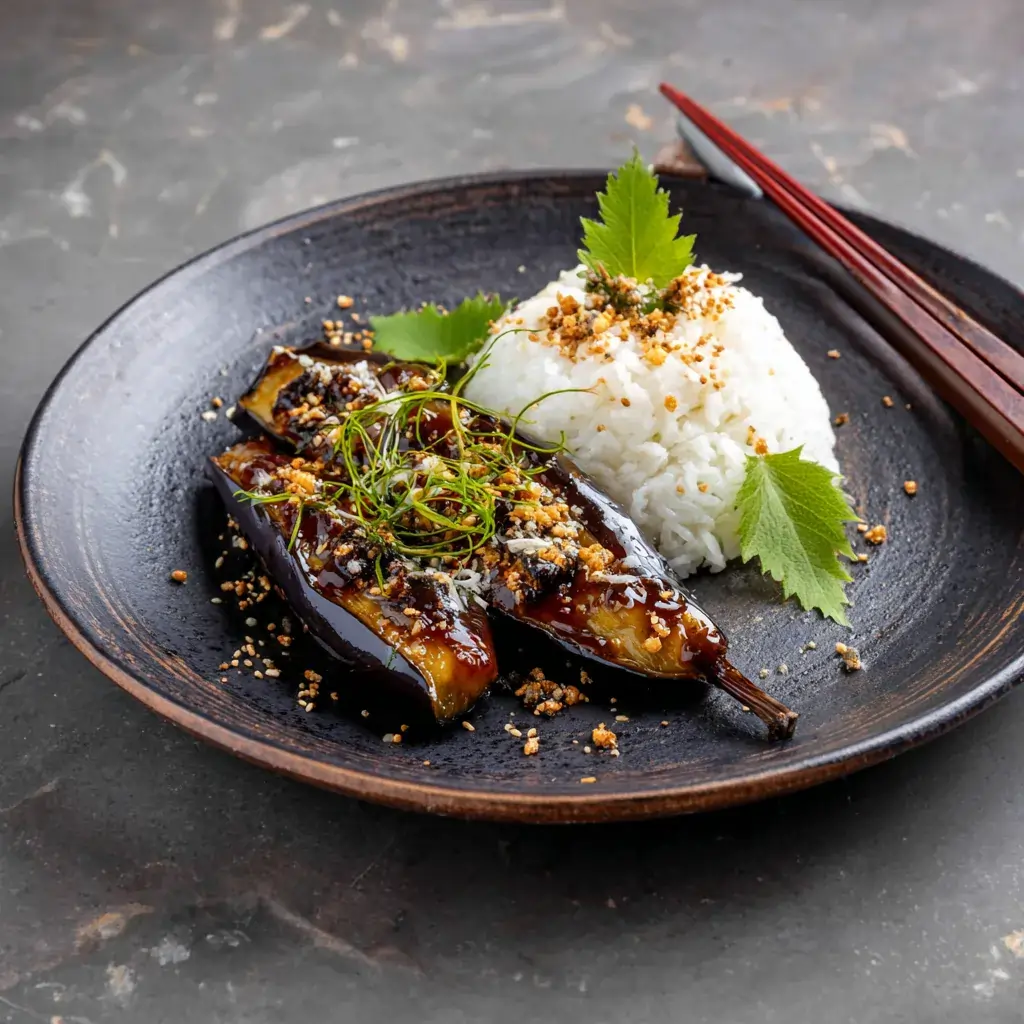
Serving Suggestions for Miso Glazed Eggplant
This versatile miso glazed eggplant shines as both a main course and an elegant side dish, pairing beautifully with a wide range of flavors and textures.
Serve your miso glazed eggplant over a bed of perfectly steamed short-grain rice to soak up every drop of that incredible glaze, or try it alongside soba noodles tossed with a light sesame dressing. For a complete Japanese meal, pair it with miso soup, edamame, and pickled vegetables. The rich, savory flavors also complement grilled fish beautifully – try it with salmon or sea bass for an elegant dinner party menu.
Wine enthusiasts will love how this dish pairs with a crisp Riesling or Gewürztraminer, whose slight sweetness balances the salty-sweet miso glaze perfectly. For beer lovers, a clean lager or wheat beer provides a refreshing contrast to the rich umami flavors. Green tea, whether hot or cold, makes an authentic and cleansing beverage choice that honors the dish’s Japanese roots.
FAQs About Miso Glazed Eggplant
Understanding these common questions will help you master this miso glazed eggplant recipe and troubleshoot any issues that might arise.
Can I make miso glazed eggplant ahead of time? You can prepare the glaze up to 3 days in advance and store it covered in the refrigerator. The eggplant is best served immediately after cooking for optimal texture, but you can prep them (scored and soaked) up to 2 hours ahead.
What if my miso glazed eggplant turns out bitter? Bitterness usually comes from skipping the soaking step or using very mature eggplants with large seeds. Always soak cut eggplant for at least 10 minutes, and choose younger, smaller eggplants when possible.
Can I use red miso instead of white miso for this eggplant recipe? Absolutely! Red miso will create a deeper, saltier flavor profile. You may want to add an extra teaspoon of sugar and mirin to balance the increased saltiness.
Is this miso glazed eggplant recipe suitable for meal prep? While best enjoyed fresh, this dish works for meal prep when stored properly. Keep the components separate and reheat gently in the oven rather than the microwave to maintain the best texture.
Can I cook miso glazed eggplant on the grill instead of in the oven? Yes! Grill the eggplant cut-side down over medium heat until tender, then flip and brush with glaze. Move to a cooler section of the grill and close the lid to finish cooking through.
Conclusion
This miso glazed eggplant recipe has become one of my most requested dishes at dinner parties, and I hope it brings the same joy to your table that it has brought to mine. The combination of tender, perfectly cooked eggplant with that glossy, caramelized miso glaze creates a dish that’s both comforting and sophisticated – exactly the kind of recipe that makes cooking feel like a delicious adventure.
Fire up your oven and try this miso glazed eggplant tonight! I promise it will change the way you think about eggplant forever. Join the thousands of home cooks who’ve discovered the magic of this simple yet elegant recipe, and don’t forget to share your creations with me on social media.
Ready for more Japanese-inspired recipes? Try my [Teriyaki Salmon with Perfect Rice] or explore my [Complete Guide to Japanese Pantry Essentials] to expand your culinary horizons. Let’s continue this delicious journey together – there’s always something amazing waiting to be discovered in the kitchen!
If you loved this recipe, don’t forget to share it with your friends or save it to try later!
I’d be thrilled to see your personal touch—share your photos on Pinterest

Miso Glazed Eggplant: A Japanese-Inspired Delight That’ll Transform Your Dinner Table
- Total Time: 35 minutes
- Yield: 4 servings 1x
Description
Tender eggplant slices glazed with a savory-sweet miso sauce, roasted to perfection. This Japanese-inspired dish is an easy, elegant, and flavor-packed addition to any dinner table.
Ingredients
2 medium eggplants, sliced lengthwise into 1/2-inch thick pieces
3 tbsp white miso paste
2 tbsp soy sauce
2 tbsp mirin
1 tbsp rice vinegar
1 tbsp sugar or honey
1 tbsp sesame oil
1 tsp grated fresh ginger
2 green onions, chopped (for garnish)
1 tsp toasted sesame seeds (for garnish)
Instructions
1. Preheat oven to 400°F (200°C) and line a baking sheet with parchment paper.
2. In a small bowl, whisk together miso paste, soy sauce, mirin, rice vinegar, sugar, sesame oil, and grated ginger to make the glaze.
3. Brush eggplant slices generously with the miso glaze on both sides.
4. Place the eggplant on the prepared baking sheet and roast 20–25 minutes until tender and caramelized, flipping halfway through.
5. Remove from oven and garnish with chopped green onions and toasted sesame seeds.
6. Serve warm as a side dish or over steamed rice.
Notes
For extra flavor, broil the eggplant for 2–3 minutes at the end for a caramelized finish.
You can substitute eggplant with zucchini for a lighter variation.
- Prep Time: 10 minutes
- Cook Time: 25 minutes
- Category: Dinner, Side Dish
- Method: Roasting
- Cuisine: Japanese
Nutrition
- Serving Size: 1/2 eggplant slice
- Calories: 120
- Sugar: 6 g
- Sodium: 550 mg
- Fat: 6 g
- Saturated Fat: 1 g
- Unsaturated Fat: 5 g
- Trans Fat: 0 g
- Carbohydrates: 15 g
- Fiber: 4 g
- Protein: 3 g
- Cholesterol: 0 mg
Keywords: miso glazed eggplant, Japanese side dish, roasted eggplant, savory miso recipe, vegetarian dinner

